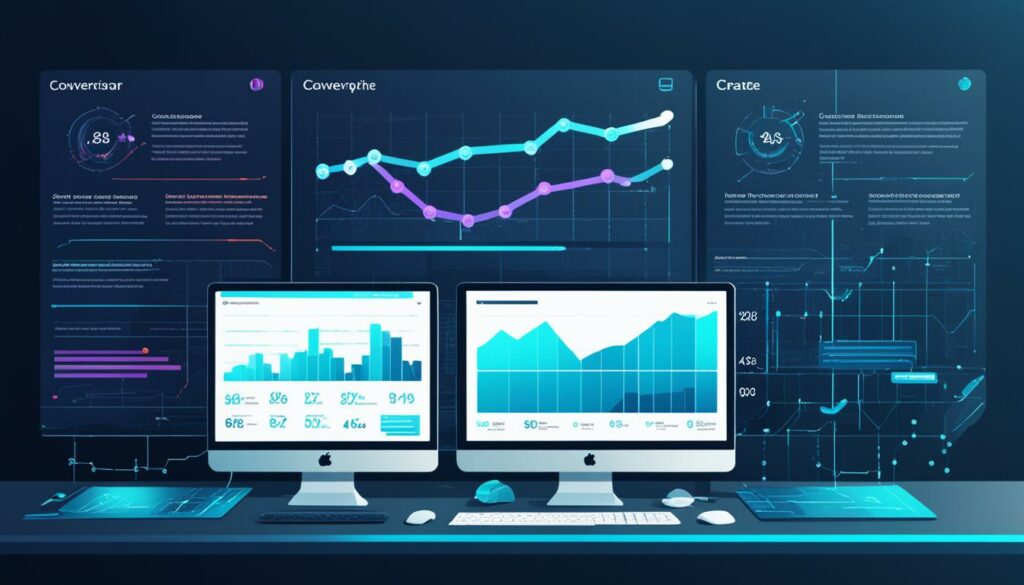Do you want to boost the performance of your website? Are you looking for effective strategies to optimize your conversion rate? Look no further than A/B testing! This powerful technique allows you to make data-driven decisions to maximize your website’s potential and achieve your business goals.
Key Takeaways:
- A/B testing is a valuable tool for optimizing websites and increasing conversion rates.
- By comparing different versions of a marketing campaign, you can determine which performs better.
- A/B testing helps eliminate guesswork in marketing strategies and enables data-driven decision-making.
- Implementing A/B testing strategies can lead to increased website traffic and improved customer engagement.
- Start A/B testing today to unlock the full potential of your website and drive business success.
What is A/B Testing?
A/B testing, also known as split testing, is a valuable marketing experiment that allows you to compare different versions of a campaign to determine which performs better. With A/B testing, you can split your audience into two groups and test variations of your campaign, such as different website layouts, headlines, or call-to-action buttons. This technique helps you understand how different audiences respond to various marketing content and enables you to optimize your marketing efforts to achieve better results.
A/B testing can be complex, but it is worth the effort. By implementing effective A/B testing strategies, you can gather valuable data and make data-driven decisions to improve your website’s performance and increase your conversion rates. It removes guesswork from your marketing strategies and allows you to fine-tune your campaigns based on real user behavior and preferences.
“A/B testing provides a scientific approach to marketing optimization, enabling businesses to make informed decisions that drive better results.” – Jane Smith, Marketing Director at ABC Company
One of the key benefits of A/B testing is that it helps you understand your audience better. By analyzing the data collected from A/B tests, you can gain insights into customer behavior and preferences. This knowledge allows you to tailor your marketing campaigns to specific audience segments, increasing engagement and conversions.
But how exactly does A/B testing work?
How Does A/B Testing Work?
To conduct an A/B test, you need to create two versions of a marketing element, like a landing page or an email template. These versions, often referred to as the control and the variant, should differ in only one aspect, called the variable. For example, the variable could be the color of a button or the placement of a headline.
Next, you split your audience into two equal groups. Group A is shown the control version, while group B is shown the variant. By tracking user interactions, such as clicks, conversions, or time spent on page, you can gather data on how each version performs.
After a sufficient period of testing, you analyze the results to determine which version performed better. The winning version becomes the new control, and you can continue to test further variations to refine your marketing campaigns. A/B testing allows you to make data-driven decisions and experiment with different strategies to optimize your conversion rates.
For a clear comparison, here’s an example of A/B testing for website headlines:
| Control Version | Variant Version |
|---|---|
| Unlock the Power of A/B Testing: Boost Your Website’s Conversion Rates! | Supercharge Your Website’s Conversion Rates with A/B Testing! |
A/B testing provides insights into what resonates with your audience and helps you make informed decisions to improve your website’s performance. By implementing effective A/B testing strategies, you can optimize your marketing campaigns and achieve higher conversion rates.
How Does A/B Testing Work?
To conduct an A/B test, you need to create two versions of a marketing element and show each version to a different group of your audience. By comparing the performance of these versions, you can gather data and make informed decisions about which version performs better. A/B testing is a powerful strategy that allows you to make data-driven decisions and experiment with different strategies to improve your conversion rates.
Let’s break down the process:
Create Two Versions
In A/B testing, you start by creating two versions of a marketing element that you want to test. This could be a website landing page, email subject line, call-to-action button, or any other element that you believe can impact your conversion rates. It’s important to only test one element at a time to accurately measure the impact of your changes.
Segment Your Audience
Next, you need to divide your audience into two groups. One group will be shown Version A, while the other group will be shown Version B. It’s crucial to ensure that the two groups are similar in terms of demographics, interests, and other relevant factors. This ensures that any differences in performance can be attributed to the variations being tested, rather than external factors.
Gather Data
Once your audience is segmented and the versions are live, you can start collecting data. Monitor the performance metrics that are relevant to your goals, such as click-through rates, conversion rates, bounce rates, or revenue generated. It’s essential to give your test enough time to reach statistical significance, meaning that you have enough data to confidently determine which version performs better.
Make Data-Driven Decisions
Based on the data collected, you can analyze the performance of Version A and Version B. Identify the version that outperforms the other and consider factors such as statistical significance, user behavior, and conversion rates. These insights will guide you in making data-driven decisions to optimize your marketing campaigns and improve your conversion rates.
A/B testing allows you to experiment with different strategies and gather concrete data to support your decision-making process. By continuously refining and optimizing your marketing elements, you can achieve better results and maximize the effectiveness of your campaigns. Experimentation is the key to unlocking the full potential of your marketing efforts.
Benefits of A/B Testing
A/B testing offers several benefits for marketers:
- Data-driven decision making: A/B testing provides tangible data to support your decision-making process, making it easier to identify and focus on strategies that generate better results.
- Improved conversion rates: By testing and optimizing your marketing elements, you can increase your conversion rates and achieve better ROI for your campaigns.
- Optimized user experience: A/B testing allows you to understand how different variations impact user behavior and preferences, enabling you to create a more tailored and personalized user experience.
- Continuous improvement: A/B testing encourages a culture of experimentation and continuous improvement, helping you stay ahead of competition and adapt to changing market dynamics.
By implementing effective A/B testing strategies, you can make informed decisions, optimize your marketing efforts, and achieve better results. Stay tuned for the next section where we explore the goals and benefits of A/B testing in more detail.
A/B Testing Goals and Benefits
A/B testing offers numerous benefits for digital marketers. By implementing effective A/B testing strategies, you can achieve various goals related to website performance, conversion rates, and customer behavior analysis. Let’s explore the key benefits of A/B testing and how it can enhance your marketing efforts.
Increased Website Traffic
A/B testing allows you to optimize different elements of your website, such as headlines, calls-to-action, and landing pages. By testing different variations and analyzing the results, you can identify which elements drive higher engagement and attract more visitors to your website. This optimization process can significantly enhance your website’s performance and increase traffic.
Improved Conversion Rates
Conversion rate optimization is at the core of A/B testing. By testing different versions of your marketing campaigns, you can determine which variations generate higher conversion rates. Whether it’s testing different layouts, images, or copywriting techniques, A/B testing enables you to optimize your campaigns based on data-driven insights, resulting in improved conversion rates.
Reduced Bounce Rates
Bounce rates refer to the percentage of visitors who leave your website without exploring further. A high bounce rate indicates that the content on your website is not engaging enough or does not align with visitors’ expectations. A/B testing can help you identify the underlying causes of high bounce rates and make data-backed changes to reduce them. By testing different elements such as page layouts, visuals, or user experience, you can create a more compelling website that keeps visitors engaged and decreases bounce rates.
Perfecting Product Images
Product images play a crucial role in driving conversions, especially for e-commerce websites. A/B testing allows you to experiment with different product images and determine which ones resonate the most with your target audience. By analyzing click-through rates, time spent on product pages, and conversion rates, you can identify the most effective product images that lead to higher sales.
Lowered Cart Abandonment Rates
Cart abandonment is a common challenge for online retailers, resulting in lost sales opportunities. A/B testing can help you identify the barriers that lead to cart abandonment and optimize the checkout process accordingly. By testing different variations, such as simplified forms, progress indicators, or trust badges, you can minimize friction and increase the chances of successful conversions.
A/B testing also provides valuable insights into customer behavior and preferences. By analyzing the data collected through testing, you can gain a deeper understanding of your audience and make informed decisions to optimize your website and marketing strategies accordingly. This data-driven approach ensures better website performance, improved conversion rates, and increased business revenue.

| A/B Testing Goals and Benefits | Description |
|---|---|
| Increased Website Traffic | Optimize website elements to attract more visitors. |
| Improved Conversion Rates | Enhance campaigns based on data-driven insights. |
| Reduced Bounce Rates | Create a more engaging website that keeps visitors exploring. |
| Perfecting Product Images | Select the most effective product images for higher sales. |
| Lowered Cart Abandonment Rates | Identify and optimize checkout barriers to reduce cart abandonment. |
Conclusion
In conclusion, A/B testing is an essential strategy for optimizing your website and improving your conversion rates. By conducting experiments and analyzing the results, you can make data-driven decisions and continuously refine your marketing strategies.
With A/B testing, you have the power to test different elements of your website and make incremental changes that can have a significant impact on your business’s success. Whether it’s testing different headlines, call-to-action buttons, or even page layouts, A/B testing allows you to see what resonates best with your audience and drives more conversions.
While A/B testing is effective, it’s worth mentioning multivariate testing as well. Multivariate testing takes A/B testing a step further by allowing you to test multiple variations of different elements simultaneously. This approach gives you more insights into how different combinations of elements can impact your website’s performance.
So, if you want to unlock the full potential of your website and drive more conversions, it’s time to implement A/B testing strategies and explore the possibilities of multivariate testing. Start experimenting, analyzing, and optimizing today to take your marketing efforts to the next level.
FAQ
Q: What is A/B testing?
A: A/B testing, also known as split testing, is a marketing experiment that allows you to compare two versions of a marketing campaign to determine which performs better in terms of conversion rate. It is a valuable tool for optimizing your website and increasing your conversion rates.
Q: How does A/B testing work?
A: To conduct an A/B test, you need to create two versions of a marketing element and show each version to a different group of your audience. By comparing the performance of these versions, you can gather data and make informed decisions about which version performs better. A/B testing helps you make data-driven decisions and experiment with different strategies to improve your conversion rates.
Q: What are the goals and benefits of A/B testing?
A: A/B testing has many benefits for marketers. It can help you achieve goals such as increasing website traffic, improving conversion rates, reducing bounce rates, perfecting product images, and lowering cart abandonment rates. A/B testing allows you to gather data about your audience’s behavior and preferences, leading to better optimization of your website and increased business revenue.












